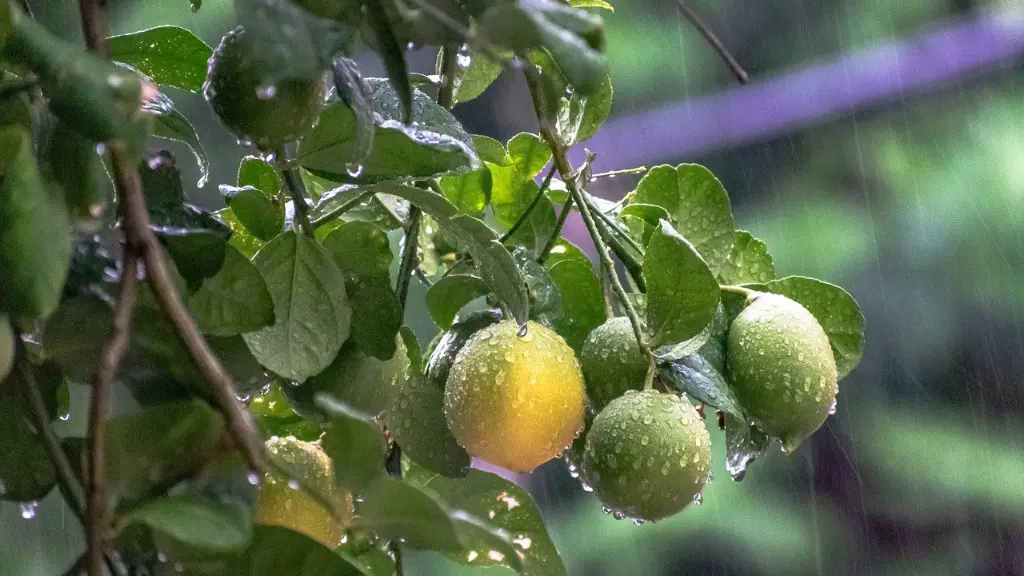Repotting a lemon tree at the right time is important to optimize its growth and prosperity. To do so, assess the citrus tree every year to determine if it is time for repotting. Ideally, repotting should take place every three to five years. Start with a good soil and small pot so that the tree does not become rootbound. Before getting started, decide on the pot size and material you would like.
When selecting the pot, make sure it is not too large or too deep. A pot that is too large can cause the soil to remain soggy and reduce oxygen levels to the roots of the tree. Additionally, avoid buying plastic or ceramic pots as they retain too much moisture. Clay, terracotta, and glazed ceramic are better options.
To prepare the tree for repotting, begin by trimming any overgrown roots. To do this, turn it upside down and gently tease the edges with a knife or pruning shears. This will help to loosen and release the soil from the sides of the container. Next, remove the tree from the pot and place it on a newspaper or a clean tarp for dust control.
Once the repotting is complete, avoid over-watering the lemon tree. Unlike other citrus varieties, lemon trees do not require heavy amounts of water. When it is time to water, check the soil before reaching for the watering can. Feel the soil around the root ball, if it is dry to the touch, then it is time to add water.
Finally, place the tree in an area where it can receive direct sunlight for at least six to eight hours a day. This is important for optimum growth and production, as lemons need plenty of sunshine for photosynthesis. Remember to fertilize regularly and provide the lemon tree with support as it grows to avoid branches breaking off.
Prune and Trim
Pruning and trimming a lemon tree is important for its overall health and growth. It is recommended to prune at least three to four times a year. When pruning, start by removing any dead wood, then shape the tree as desired. A general rule of thumb is to prune or trim the same amount of growth that was made during the previous season.
When shaping the tree, make sure to cut back to the lowest part of the canopy. This will help to encourage new growth and provide balance to the tree. Additionally, it is important to prune gently, taking off small amounts at a time. Cutting too much off at once can shock the tree.
When removing leaves, begin at the bottom of the tree and work your way up. This will help to keep the root system healthy and boost the amount of sunshine that reaches the lower branches. It is important to keep the lemon tree’s canopy open, with enough room for air and light to flow through.
Finally, use sterilized pruning tools when cutting any parts of the tree. This will prevent the spread of bacteria or fungi from one part of the tree to another. It is also important to make sure the blade is sharp, as it will reduce the risk of tearing the bark of the tree.
Feeding and Fertilizing
Feeding and fertilizing a lemon tree is an important part of keeping it healthy. The fertilizer should be selected based on the age and size of the lemon tree, as this will determine the amount of food it needs. If the tree is younger, a fertilizer with a higher nitrogen content is ideal.
It is important to feed the tree gradually over the course of the season, as a sudden surge of nutrients can shock the tree. Additionally, fertilize around the base of the trunk and not near the leaves, as this can burn them. When it comes to watering, plan to do so around the same time as you feed the tree.
Organic fertilizers can also be used for a lemon tree. Composted manure, fish emulsion, and seaweed extract are all excellent options. Manure can be added to the soil once a year and seaweed can be applied every two weeks. Additionally, these fertilizers can help to improve the soil composition.
Finally, compost tea can also be used to feed a lemon tree. To make compost tea, take 1 cup of aged compost and add it to a gallon of water. Let the mixture sit for at least 24 hours and then use to feed the tree. Compost tea is excellent for adding additional nutrients to the soil and can be used once or twice a month.
Pests and Diseases
Citrus trees can be susceptible to various pests and diseases, many of which can be indicative of a larger issue such as improper watering or improper care. Common pests that may attack a lemon tree include aphids, scale, and mealybugs. These can be controlled by the use of insecticides or by introducing natural predators like ladybugs or lacewings.
Another common pest is the citrus root borer, which feeds on the roots of the tree. To control this pest, it is important to use biological control methods such as nematodes. Additionally, make sure the soil is not too moist, as this can attract the root borer.
Fungal diseases such as blight and powdery mildew can also affect a lemon tree. To prevent these diseases, avoid overhead watering and make sure the tree has adequate air circulation. Pruning can help to reduce the amount of foliage moisture, as well as enable more sunlight to reach the lower parts of the tree.
To control bacterial diseases such as citrus scab, it is important to avoid overhead watering and remove any infected branches or leaves. Additionally, inspect the tree regularly to identify any potential issues before they can spread. This can help to prevent any further damage to the tree.
Fruit Pruning
Fruit pruning is also necessary for lemon trees, as it helps to make sure only the best fruits are produced. To do this, prune off any fruits that are not fully ripened, or that are below the size of a golf ball. This will help the tree to focus on producing higher quality fruits.
In addition to removing the fruits, pruning the branch tips can be beneficial. This can help to promote the lateral growth of the branches, which in turn produces more flowers and fruits. Pruning should be done in the early fall or winter to avoid stressing the tree.
It is also beneficial to keep the ground around the tree free of weeds and debris. Dead branches, leaves, and other debris should be removed to make sure the tree receives enough oxygen, light, and nutrients. Occasional hand weeding and mulching can also be helpful.
Finally, it is important to monitor the quantity of fruits the tree produces. Pruning off the excess fruits can help to prevent branches from breaking or overloading. This will ensure the tree does not have to work too hard to produce more fruits.
Harvesting and Storage
When harvesting, avoid picking unripe fruits as they can cause indigestion or digestion problems. The best way to tell if a fruit is ripe is to smell it and check the skin. Harvests should also be done in the early morning, to reduce the spread of any diseases.
Fruits can also be stored for up to a week if they are kept in a cool, dry place. Ripe fruits should be covered to protect them from moisture or cold. Unripe fruits can be kept in a paper bag to allow them to ripen in the best possible environment.
Once the lemons are ready to be used, it is important to clean and store them properly. Before using the lemons, rinse them in cool, clean water to remove any residue from the environment. This will help to prevent bacteria or fungi from developing on the fruits.
Once the lemons have been washed, store them in the refrigerator for up to two weeks. Wrapping the fruits individually in a plastic bag can help to keep them from drying out. Additionally, freezing slices of lemon can be a great way to preserve the flavor and extend their life.
Conclusion
With proper maintenance and care, a lemon tree can be a great addition to any garden. Regularly feeding and fertilizing, repotting, pruning, and harvesting are all important tasks to ensure your tree is healthy and fruitful. By following these steps, you can ensure your lemon tree remains healthy and produces plenty of delicious lemons!





